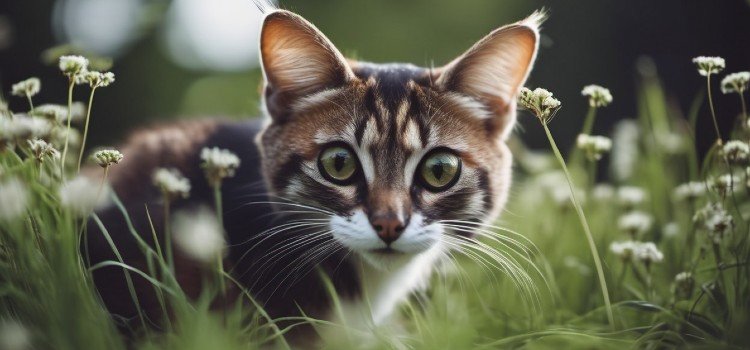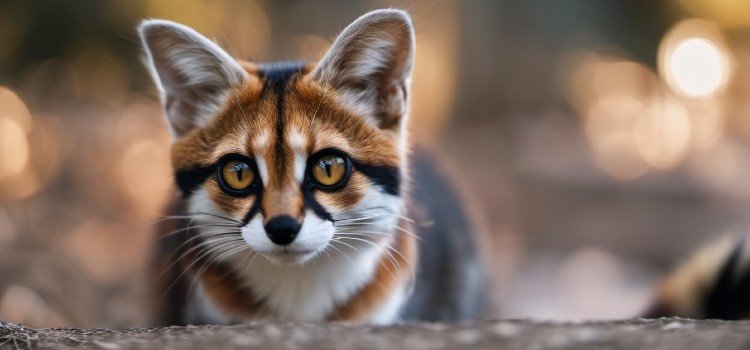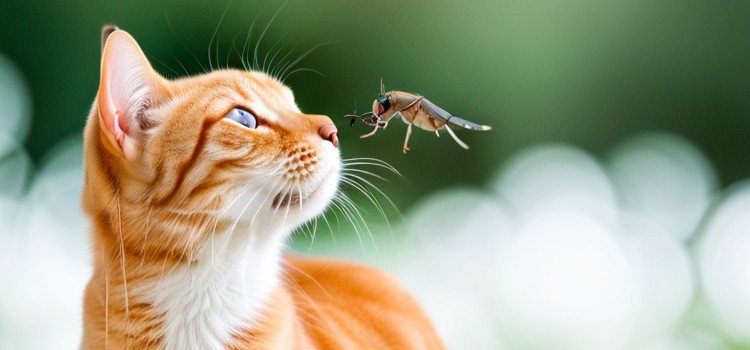As an Amazon Associate committed to the mission of improving the lives of our readers, Live-Clear.com receives a small commission from eligible purchases made through our affiliate links. This revenue enables us to keep producing insightful articles and other material.
Ringtail cats are not typically dangerous, as they are generally shy and non-aggressive towards humans. However, they may bite if they feel threatened or cornered.
Ringtail cats are small mammals native to North America. Despite their name, they are not actually cats but belong to the raccoon family. Known for their distinctive bushy tails with alternating black and white rings, ringtails are solitary animals that are primarily nocturnal.

They are skilled climbers and have adapted to various habitats, including deserts, forests, and rocky areas. While ringtails are not usually aggressive towards humans, they may bite if they feel threatened or cornered. Like any wild animal, it is important to respect their space and observe them from a distance. Ringtails typically feed on small prey, fruits, and insects. They play a significant role in maintaining the balance of their ecosystem by controlling rodent populations and dispersing seeds. While ringtail cats are not inherently dangerous, it is crucial to exercise caution and avoid approaching or provoking them to prevent any potential harm.
Physical Characteristics Of Ringtail Cats
When it comes to understanding ringtail cats, it is essential to examine their physical characteristics, which provide valuable insights into their behavior and potential danger. Let’s take a closer look at the size and weight, fur and tail, as well as eyes and ears of ringtail cats.
Size And Weight
Ringtail cats are small to medium-sized creatures, measuring around 12 to 17 inches in length from nose to tail. They typically weigh between 1.5 to 3.5 pounds, making them lightweight but agile predators.
Fur And Tail
Their fur is soft and dense, offering them protection from cold weather conditions. Ringtail cats have long, fluffy tails that are nearly as long as their bodies. Their tails play a vital role in balance and communication, often acting as a visual signal to other animals.
Eyes And Ears
With their keen sense of sight, ringtail cats possess luminous eyes that are proportionally larger than their head size. Their eyes have vertical pupils, allowing them to adapt to different light conditions efficiently. In addition to their remarkable eyesight, they have highly sensitive ears, which enable them to detect even the faintest of sounds, making them alert and cautious animals.
Habitat And Distribution
When it comes to understanding the nature of ringtail cats, one important aspect to explore is their habitat and distribution. By delving into this topic, we can gain insights into their natural habitat, the regions they are found in, and their remarkable adaptations. So, let’s dive in and learn more about these fascinating creatures and their environment.
Natural Habitat
Ringtail cats are primarily found in the western United States and parts of Mexico. They inhabit a diverse range of environments that offer rocky areas, such as canyons, cliffs, and desert regions. These nocturnal animals have a particular affinity for rocky habitats with ample vegetation and water sources. They are adept climbers, perfectly suited for navigating the rugged terrain and vertical surfaces they call home.
Geographical Distribution
The geographical distribution of ringtail cats extends across a specific range, which includes states like California, Arizona, Nevada, New Mexico, and Texas within the United States. Additionally, they are also found in the northern parts of Mexico, particularly in Sonora, Chihuahua, and Baja California. Research suggests that ringtail cats are most abundant in canyon regions, where they can find an abundance of prey and suitable dens for shelter.
Adaptations Of Are Ringtail Cats Dangerous
Ringtail cats possess several remarkable adaptations that enable them to thrive in their unique environment. For instance, their long tail, measuring roughly the same length as their body, allows them to maintain balance while maneuvering through rocky terrains and narrow surfaces. This adaptation is especially crucial as they navigate steep cliffs and rocky crevices in search of food and escape from predators.
Moreover, their paws are well-equipped with sharp, curved claws, enabling them to grip onto various surfaces while climbing trees and rocks. Their claws are particularly efficient in enabling quick movement and capturing prey. In addition to their physical adaptations, ringtail cats have sharp senses, including excellent vision and hearing, enabling them to be successful nocturnal hunters in their rocky habitats.

Behavior And Diet
Ringtail cats are fascinating creatures known for their unique behavior and diet. In this section, we will explore their nocturnal behavior, social behavior, and dietary habits.
Nocturnal Behavior
Ringtail cats are primarily nocturnal, which means they are most active during the night. Their keen sense of hearing and excellent night vision allows them to navigate in the darkness with ease. These agile creatures spend their nights climbing trees, jumping from branch to branch, and exploring their surroundings in search of food.
Social Behavior
When it comes to social behavior, ringtail cats are relatively solitary animals. They prefer to live alone and establish their territory, usually in rocky areas or tree hollows. However, during the mating season, males may begin to exhibit territorial behavior, marking their territory with scent glands to attract potential mates.
Dietary Habits
Ringtail cats are omnivores with dietary habits that vary depending on their natural habitat. Their diet primarily consists of small mammals, insects, rodents, birds, fruits, and vegetation. They have a remarkable ability to adapt their diet according to the available resources. This adaptability enables them to survive in diverse environments, ranging from desert regions to forests.
Below is a table summarizing the dietary habits of ringtail cats:
| Primary Food Sources | Secondary Food Sources |
|---|---|
| Small mammals | Insects |
| Rodents | Birds |
| Fruits | Vegetation |
Ringtail cats have a diverse diet, allowing them to adapt to various environmental conditions and ensuring their survival.
Ringtail Cats And Humans
Ringtail cats are not typically dangerous to humans, as they are shy and avoid confrontation. However, it’s important to remember they are wild animals and should be appreciated from a safe distance.
Are Ringtail Cats Dangerous For Interactions With Humans
Ringtail cats, while fascinating creatures, often have interactions with humans that are both intriguing and enjoyable. These small carnivores are known for their curious and friendly nature, making them an interesting subject for observation and study.
One common interaction between ringtail cats and humans is their occasional presence in residential areas. Because of their adaptable behavior, they actively seek shelter in attics, garages, and even abandoned buildings. These interactions offer a unique opportunity for homeowners to catch a glimpse of these elusive creatures.
Ringtail cats also have a habit of raiding bird feeders and scavenging for food in outdoor spaces, leading to further encounters with humans. Their agile movements and the distinctiveness of their long, banded tail make them easy to spot, often leaving residents captivated by their beauty. However, it is important to remember that these interactions should be approached with caution and respect for the animal’s natural habitat.
Are Ringtail Cats Dangerous As Pet?
Although ringtail cats may seem captivating, it’s crucial to recognize that they are not suitable as pets. While their cuddly appearance and playful behavior may be appealing, these creatures have specific needs that cannot be adequately met within a domestic setting.
Ringtail cats are highly territorial, and attempting to keep them in captivity can lead to stress and aggression. These wild animals require a vast amount of space to roam, explore, and exhibit their natural behaviors. Enclosing them in small enclosures or homes, therefore, can have detrimental effects on their physical and mental well-being.
Additionally, ringtail cats possess sharp teeth and claws, which they use to catch prey and defend themselves. While this may be advantageous for their survival in the wild, it can pose a significant danger to humans if they are kept as pets.
Are Ringtail Cats Dangerous?
While ringtail cats are generally not aggressive toward humans, some potential dangers exist when these creatures come into contact with people.
- Ringtail cats, like any wild animal, can carry diseases such as rabies. It is best to avoid direct contact with them to minimize the risk of transmission.
- If a ringtail cat feels threatened or cornered, it may scratch or bite in self-defense. It is important to keep a safe distance and respect their space.
- When encountered in urban areas, ringtail cats have been known to create disturbances by making their nests in attics or other areas of the home. This can pose a risk of property damage and may require professional intervention to resolve.
In conclusion, while ringtail cats can be a captivating and unique addition to our surroundings, it is crucial to maintain a respectful distance and appreciate their natural behaviors from afar. Understanding their interactions with humans and the potential dangers they pose helps create a harmonious coexistence between these fascinating creatures and ourselves.

Ringtail Cats As Predators
Ringtail cats are fascinating creatures known for their unique appearance and behaviors. While they may look adorable with their bushy tails and large eyes, it’s important to understand their role as predators in the animal kingdom. Let’s explore how these creatures function as hunters and the impact they have on the ecosystem.
Prey Preference Of Are Ringtail Cats Dangerous
Ringtail cats have a diverse diet and are opportunistic predators. While they primarily feed on small mammals such as rodents and rabbits, they are known to adapt their diet according to availability. These resourceful creatures can also consume birds, reptiles, amphibians, insects, and even fruits. Their ability to adjust their prey preference allows them to survive in various environments.
Hunting Techniques
When it comes to hunting, ringtail cats possess exceptional skills that make them successful predators. They are stealthy and agile, using their sharp claws, keen hearing, and night vision to their advantage. These unique adaptations allow them to navigate through different types of terrain and pounce on unsuspecting prey. Their slender bodies and long tails aid in maintaining balance and jumping from branch to branch with ease. By utilizing these hunting techniques, ringtail cats are able to secure their meals effectively.
Impact On Ecosystem
The presence of ringtail cats in an ecosystem is not only beneficial but also necessary for maintaining balance. As predators, they help control populations of pests such as rodents, which can pose a threat to crops and human settlements. Additionally, as part of the food chain, they contribute to the overall biodiversity of their habitat. Their varying diet and hunting techniques make them valuable contributors to the ecosystem’s stability.
In conclusion, ringtail cats are versatile predators with diverse prey preferences and exceptional hunting techniques. Their presence in the ecosystem plays a critical role in maintaining balance and preserving biodiversity. Understanding their role as predators allows us to appreciate these remarkable creatures and their value in the animal kingdom.
Conservation Status And Protection Of Ringtail Cat
Ringtail cats have a conservation status of least concern, meaning they are not currently at risk. However, it is important to protect their natural habitats and avoid interactions, as they can carry diseases such as rabies.
Threats To Are Ringtail Cats Dangerous
Ringtail cats, also known as ringtails, are small nocturnal mammals that inhabit the western part of North America. While they may not be well-known compared to other animals, these delightful creatures face several threats that affect their population and overall survival.
- The destruction of their natural habitat poses a significant threat to ringtail cats. As urbanization continues to encroach upon their territories, there is less space for these animals to forage and seek shelter.
- Furthermore, the introduction of non-native predators has become a menace for ringtails. Predators such as domestic cats, dogs, and coyotes pose a direct threat to their existence, as ringtails have not evolved strategies to defend against these new predators.
- Another danger that ringtail cats face is the loss of suitable nesting sites. They prefer nesting in tree cavities or rocky crevices, but deforestation and human activities have reduced the availability of these crucial habitats.
- In addition, ringtails are also at risk due to road mortality. Cars frequently hit them when they attempt to cross roads, as their adaptation to climbing trees and rocks doesn’t adequately equip them to avoid vehicles.
Conservation Efforts Of Are Ringtail Cats Dangerous
Recognizing the importance of preserving biodiversity and protecting vulnerable species like ringtails, several efforts are being made by organizations and individuals to conserve their populations.
- One significant conservation effort focuses on habitat restoration. This entails replanting trees and gardens, creating wildlife corridors, and protecting their natural habitats from further destruction.
- Another essential conservation measure is the promotion of public awareness about ringtails. Educating communities about the importance of coexisting with these creatures can lead to greater understanding and appreciation, reducing the threats they face.
- Moreover, initiatives to control the population of non-native predators are being implemented. Managing the populations of domestic cats, dogs, and coyotes actively reduces the risk to ringtails significantly.
- Conservationists are also engaging in research to better understand ringtail behavior, ecology, and population dynamics. This knowledge will inform future conservation efforts, aiding in their successful implementation.
- Lastly, fostering partnerships between government agencies, conservation organizations, and local communities are essential for sustained conservation efforts. These collaborations help ensure effective protection and management of ringtail populations.
Laws And Regulations For Ringtail Cat
To safeguard ringtail cats and their habitats, various laws and regulations have been established:
| Law/Regulation | Purpose |
|---|---|
| Endangered Species Act (ESA) | Protects ringtails by listing them as federally endangered, making it illegal to harm or trade them. |
| State Wildlife Laws | Individual states have enacted laws that prohibit hunting, trapping, or killing of ringtail cats without proper licenses or permits. |
| Habitat Conservation Plans (HCPs) | These plans work towards protecting vital ringtail habitats and implementing measures to mitigate the threats they face. |
| Land Use Policies | Establishing guidelines for land development to minimize the impact on ringtail habitats and promote their conservation. |
These laws and regulations play a crucial role in ensuring the conservation and protection of ringtail cats and their habitats, helping to secure their future in the wild.

Conclusion On Are Ringtail Cats Dangerous
To sum up, while ringtail cats may appear intimidating, they are generally not dangerous to humans. These nocturnal creatures play a crucial role in maintaining the ecosystem, primarily as insect and rodent controllers. However, it’s crucial to remember that they are wild animals and should be treated with caution, especially if encountered in the wild.
Frequently Asked Questions Of Are Ringtail Cats Dangerous
Ringtail cats are generally not dangerous to humans. They are timid and shy creatures that prefer to avoid human interaction.
While some states permit ownership of ringtail cats as pets, it’s not advisable because of their wild nature and the specific care they demand.
Ringtail cats are omnivores and their diet consists of a variety of foods including insects, small mammals, birds, fruits, nuts, and vegetables.
Like other wild animals, ringtail cats can carry diseases such as rabies. It is important to avoid contact with them to minimize the risk of transmission.
Ringtail cats roam native in the southwestern United States, thriving in rocky habitats like canyons, caves, and desert areas.
By learning more about ringtail cats and respecting their natural habitat, we can coexist peacefully with these fascinating creatures.
Amazon and the Amazon logo are trademarks of Amazon.com, Inc, or its affiliates.



